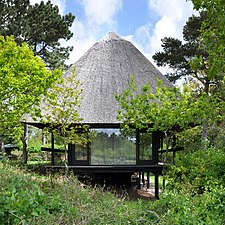Engawa
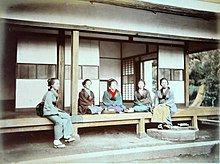

Anengawa(Duyên sườn / duyện sườn)oren(Duyên)is an edging strip of non-tatami-matted flooring inJapanese architecture,usually wood or bamboo. Theenmay run around the rooms, on the outside of the building, in which case they resemble aporchorsunroom.
Usually, theenis outside the translucent papershōji,but inside theamado(Vũ hộ)stormshutters(when they are not packed away).[1][2]However, someenrun outside theamado.Enthat cannot be enclosed byamado,or sufficiently sheltered by eaves, must be finished to withstand the Japanese climate.[3]Modern architecture often encloses anenwith sheet glass. Anengawaallows the building to remain open in the rain or sun, without getting too wet or hot, and allows flexible ventilation and sightlines.[4]
The area under anengawais sloped away from the building, and often paved, to carry the water away. The area directly outside the paving is usually acollector drainthat takes water still further away.[3]Theengawais thus a way to bridge the obstacles good drainage puts between the indoors and the outdoors.
Structure
[edit]Theengawais supported on posts, identical to the other uprights of the house.[5]A row of uprights runs long the inside of theengawa,and theshōjisliding screens run between these; a second row of uprights runs along the outside of theengawa.[6]The posts traditionally stand on half-buried stones,[5]pounded into the earth with a specialized maul, and the wood posts shaped to fit the upper surface.[6]More recent houses may use concrete footings.
Theengawafloor may not be finished, or it may be polished or lacquered.[5]
Terminology
[edit]
Enmeans an edge;gawaa side.[7]The termsenandengawawere historically used interchangeably,[8][9]butengawanow generally refers to theverandadirectly outside the shutters.[citation needed]Types ofeninclude:
Positional terms
[edit]- hiro-en(Quảng duyên),an inneren,possibly enclosed
- ochi-en(Lạc duyên),anenset one step below the floor (oren) inside it
- nure'en(Nhu れ duyên,lit. 'a weten'),anenprotruding from under theeavesand not protected byamado.
If there are fewer than threeen,anenmay be described by more than one of the positional terms.[10][11]
Structural terms
[edit]- mawari-en(Hồi duyên),a wrap-arounden,often a wrap-around veranda
- kirime-en(Thiết mục duyên),aenwith boards running across its width
- kure-en(Phù duyên),aenwith boards running along its length
- sunoko-en(Trách tử duyên),a veranda with a slatted floor for better drainage
- takesunoko-en(Trúc trách の tử duyên),a bamboosunoko-en
-
Mawari-en,anenwhich continues all around the building
-
Kure-en.The gravel path may well double as acollector drain.
-
Fast-drainingtakesunoko-enin lower right corner, near a tap
-
Takesunoko-enin the Geppa-rō rustic tea pavilion, overlooking the water atKatsura Imperial Villa(close-up,drainage)
-
Broadnure-enatKiyomizu-dera;the dry section may be seen to the right.
Relation to other house components
[edit]The core of a traditionalShinden-stylebuilding was the innermost room ormoya(Mẫu phòng)(see diagram). This was surrounded by thehisashi(Sương, tí),which was on the same level, and was usually inside the windows andshitomistorm shutters. Thehisashiwas often a ring of tatami-floored rooms, but could be an unmatteden;see alsohirobisashi(Quảng sương / quảng tí / hoằng sương).In a large building, there could be further layers of tatami-floored rooms,[12]courtyards, and further floorplan complications.
InShoin-stylebuildings, the positioning of theengawavaried more, and the storm shutters slid rather than being hinged (usually horizontally). The modernSukiya-styleof building usesamado,storm shutters that not only slide but pack away in a cupboard called ato-bukuraby day; unlike the Shoin-style shutter, these generally run on the outside of theengawa.
The width of anengawavaries with the building; 1–1.3 m (3 ft 3 in – 4 ft 3 in) is common, while large temples may have over 3 metres (9.8 ft) ofengawa.Theengawais supported on posts, identical to the other uprights of the house. The posts stand on half-buried stones[5]or concrete footings.
-
Enlooking onto a courtyard, illustrationc. 1130
-
Lowkirime-enrunning around atsubo-niwacourtyard, 2012
-
After rain; the eaves have kept theenmostly dry, and theenhas kept the foundations of the house quite dry.
Cultural role
[edit]Engawaare often proportioned so that one can sit on the edge and observe the garden.[14]They provide a space for playing children and casual visitors.[4]
Anengawais part of the house, and shoes are therefore not worn on it. Guests' shoes are lined up pointing outwards.
Whileengawadeclined with the Westernization of Japanese architecture,[4]they are making a comeback in modern architecture.[4][15]
-
Cushions on anengawaprotected by sliding glass doors. Notefume-ishi,stone step.
-
Anengawais part of the house, and shoes are therefore not worn on it.
-
AnengawaoverlookingErin-ji Gardens.
-
Anengawacan open the house to the surrounding landscape.
-
Socializing on anengawa.
-
Traditionalenin fancier buildings often have low railings,[5]for leaning on while sitting on theen.Westernization of clothing made sitting on the floor difficult; modernenoften have standing-height railings
-
Left, anenrunning between buildings, joining them.
-
Modernmawari-eninDenmark.
See also
[edit]References
[edit]- ^Duyên[En].TheDaijisen.Shougakukan.1995.
- ^"Shoji Screens".rothteien.
- ^abA., Kester, Jeffery (18 March 2017)."The Kester House & Garden".kesterhouse.
{{cite web}}:CS1 maint: multiple names: authors list (link) - ^abcdDuits, Kjeld (14 June 2008)."1890s • Woman in Room".Old Photos of Japan.
- ^abcdeEdward S. Morse (1885). "5: Entrances and Approaches".Japanese Homes and their Surroundings.
{{cite book}}:|website=ignored (help) - ^abEdward S. Morse (1885). "1: The House".Japanese Homes and their Surroundings.
{{cite book}}:|website=ignored (help) - ^"The definition of engawa".dictionary.
- ^"Engawa duyên sườn".aisf.or.jp.Japanese Architecture and Art Net Users System.Retrieved2008-07-20.
- ^"En duyên".aisf.or.jp.Japanese Architecture and Art Net Users System.
- ^"Nure-en nhu duyên".aisf.or.jp.Japanese Architecture and Art Net Users System.
- ^"Ochi-en lạc duyên".aisf.or.jp.Japanese Architecture and Art Net Users System.
- ^"Shinden-zukuri tẩm điện tạo".aisf.or.jp.Japanese Architecture and Art Net Users System.
- ^"Hisashi sương".aisf.or.jp.Japanese Architecture and Art Net Users System.
- ^"ELEMENTS - The Engawa".Archiscapes. 15 January 2015.
- ^Reinholdt, Eric (9 December 2014)."Design Workshop: How the Japanese Porch Makes a Home Feel Larger".Houzz.

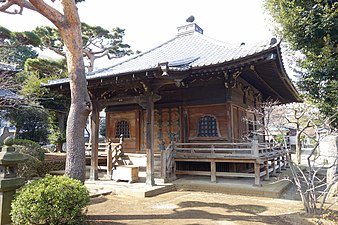





![Moya and hisashi. The hisashi may itself be an en in small buildings, or it may be a second layer of tatami-floored rooms, with a hard-floored en running outside it.[13]](https://upload.wikimedia.org/wikipedia/commons/thumb/2/27/Moya_hisashi.svg/225px-Moya_hisashi.svg.png)

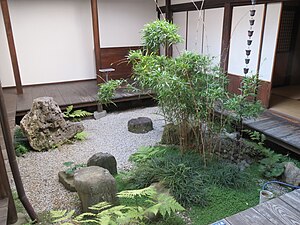

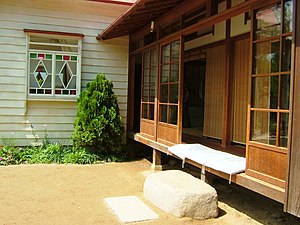
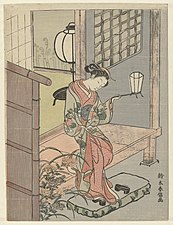




![Traditional en in fancier buildings often have low railings,[5] for leaning on while sitting on the en. Westernization of clothing made sitting on the floor difficult; modern en often have standing-height railings](https://upload.wikimedia.org/wikipedia/commons/thumb/c/c6/%E3%80%8E%E9%9B%A8%E9%81%8E%E6%B4%97%E5%BA%AD%E4%B9%8B%E5%9B%B3%E3%80%8F-A_Garden_Refreshed_by_the_Passing_Rain_%28Ukasentei_no_zu%29_MET_DP147704.jpg/452px-%E3%80%8E%E9%9B%A8%E9%81%8E%E6%B4%97%E5%BA%AD%E4%B9%8B%E5%9B%B3%E3%80%8F-A_Garden_Refreshed_by_the_Passing_Rain_%28Ukasentei_no_zu%29_MET_DP147704.jpg)

